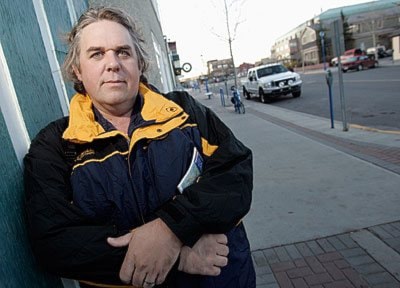Whitehorse doesn’t need another shelter — they create chronic homelessness, says Toronto street outreach officer Toby Druce.
“There is nothing about a shelter that helps someone who is in crisis move forward,” said Druce, who was in the territory to speak during Homelessness Action Week.
He champions housing.
“You won’t know what problems someone is dealing with until they’re housed,” he said.
A homeless person who swears a blue streak during normal conversations will not do well in an interview with a potential landlord.
However, they might have uncontrolled diabetes. And, if they were to get regular insulin shots, the verbal aggression would lessen, or disappear entirely.
But that diabetes can’t be stabilized until they’re housed, said Druce.
Once that person has a home, you can take a comprehensive look at how they sleep, when they had their last medical exam and other things.
“So their behaviour on the street isn’t going to be indicative of their behaviour in housing,” said Druce.
“If you deal with their behaviour on the street, you’ve done nothing to move them toward a more permanent housing solution.”
You may assume you know the reason why someone is homeless, and that may have absolutely nothing to do with their homelessness, said Druce.
Many people use emergency shelters for very short periods of time, and then proceed to solve their homelessness problem on their own, said Druce.
“But there’s a small group of people who will not be able to solve their homelessness on their own, for whom shelter doesn’t provide any sort of meaningful move towards housing,” he said.
“It entrenches you in a daily routine that is all about surviving homelessness.
“And we’re not interested in helping people survive their homelessness — we want to help people end their homelessness, but you can’t do that in a shelter.”
The Salvation Army shelter, Whitehorse’s only emergency shelter, has 10 beds. And on average four of them are used by people who are chronically homeless, said Salvation Army Cpt. Robert Sessford.
“But I don’t believe our shelter encourages a delinquent lifestyle,” he said.
The Sally Ann supports people who suddenly lose housing, through eviction or fire, and it helps to stabilize the chronically homeless so they can eventually move into their own places, said Sessford.
“I totally appreciate if you have nowhere to sleep, emergency shelters have a role,” said Druce. “If somebody’s house burns down today, they need somewhere to sleep tonight.
“But if you’re homeless for more than six weeks, the shelter has stopped being an effective response.
“You want people to stay long enough that you can figure out what the solution is, but you don’t want them to stay so long that this temporary measure becomes part of their problem.”
Trouble is, some of the chronically homeless need semi-supported living, said Sessford.
“They can’t care for a place 100 per cent on their own — they’re disabled in some way.”
In Toronto, Druce and his city team find housing for the homeless by talking economics with landlords.
If a person has vacancies in their building, it’s better to drop the rent a little, making it affordable to someone on social assistance, than to have them sit empty, he said.
“And we guarantee the rent (through social assistance) and we guarantee follow-up.”
Every homeless person who is placed in a rental unit has a follow-up worker who tries to solve any problems that arise, staving off possible eviction.
That’s exactly what Whitehorse needs, said Sessford.
“We don’t need another shelter,” he said.
“But we definitely need support people to work with people who get their own places and to ensure they don’t get evicted.”
Sessford watches clients get housing only to show up at the shelter again a few months later.
“We lack the resources to hire a full-time person to do constant follow-ups,” he said.
And some people might need follow-ups for a very long time, he added. “I’m talking forever.”
The money it costs to run 10 shelter beds in Whitehorse is probably the equivalent of 50 rent subsidies, said Druce.
“Shelters are expensive. So, why not just move them into housing?
“You’d go farther trying to provide rent supplements than you would trying to provide them an emergency shelter.”
Druce doesn’t have time for affordable housing either.
“To depend on affordable housing to solve your homelessness problem is fatal,” he said.
“Because it’s not going to happen.”
If there are 25 vacancies in Whitehorse right now, fill them, said Druce.
“Because if you say, we’re going to build 25 units of affordable housing, that’s not going to happen this winter.”
Rather than having subsidized blocks of housing, it makes more sense to subsidize individual units, said Sessford.
“When we cluster low-income, or subsidized, housing we get slums,” he said.
“It’s not as effective for a positive lifestyle for everyone, including those who aren’t low-income.”
A new 30-unit affordable housing complex going up in Riverdale has already met with condemnation from area residents concerned about the impact it will have on their neighbourhood.
Affordable housing meets a range of needs, said Druce.
“I mean, they’re building affordable housing in BC now for tenured professors at the University of British Columbia.
“They’re having trouble finding affordable housing — so if they’re having trouble, God knows, the rest of us are screwed.”
